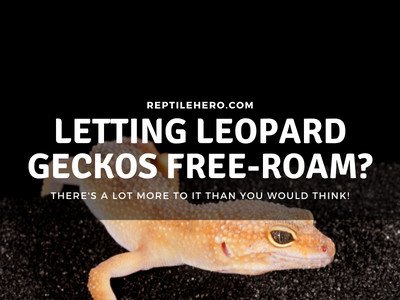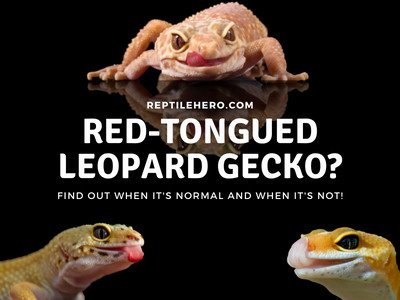Deep Heat Projectors For Leopard Geckos? [Final Guide]
Have you heard of deep heat projectors and wondered if you should use them? Are they safe? Do they really improve your gecko’s overall well-being? The reptile-keeping community has come quite a long way in terms of husbandry practices and standards. As a result, numerous companies have been releasing innovative heat sources as the so-called deep heat projectors to keep up with the growing demands of well-informed pet parents.
Generally, a deep heat projector will serve as a great heat source in a leopard gecko tank because it produces infrared A, B, and C with virtually no visible light. It is recommended as a supplemental heating element for day and night to improve and maintain ideal basking and ambient temperatures within the enclosure.
Are you worried your little gecko companion might not make it through the harsh and bone-chilling winter months? Well, many keepers have prevented their sick or young leopard geckos from having to tough it out during brumation. Read on for more details!
What is a Deep Heat Projector and How Does It Work?
Carbon infrared heaters, more commonly known as deep heat projectors, emit all types of infrared electromagnetic radiation (also commonly but wrongly called light) for efficient full-body and space heating.
However, a carbon heater produces little to no visible light at all even when it is operated at full power. Most of its energy is emitted as infrared.
Deep heat projectors have become all the rage in not just the leopard gecko circle but the whole reptile-keeping community as a whole. Now, they are even considered the best heat source for species known to be more light-sensitive.
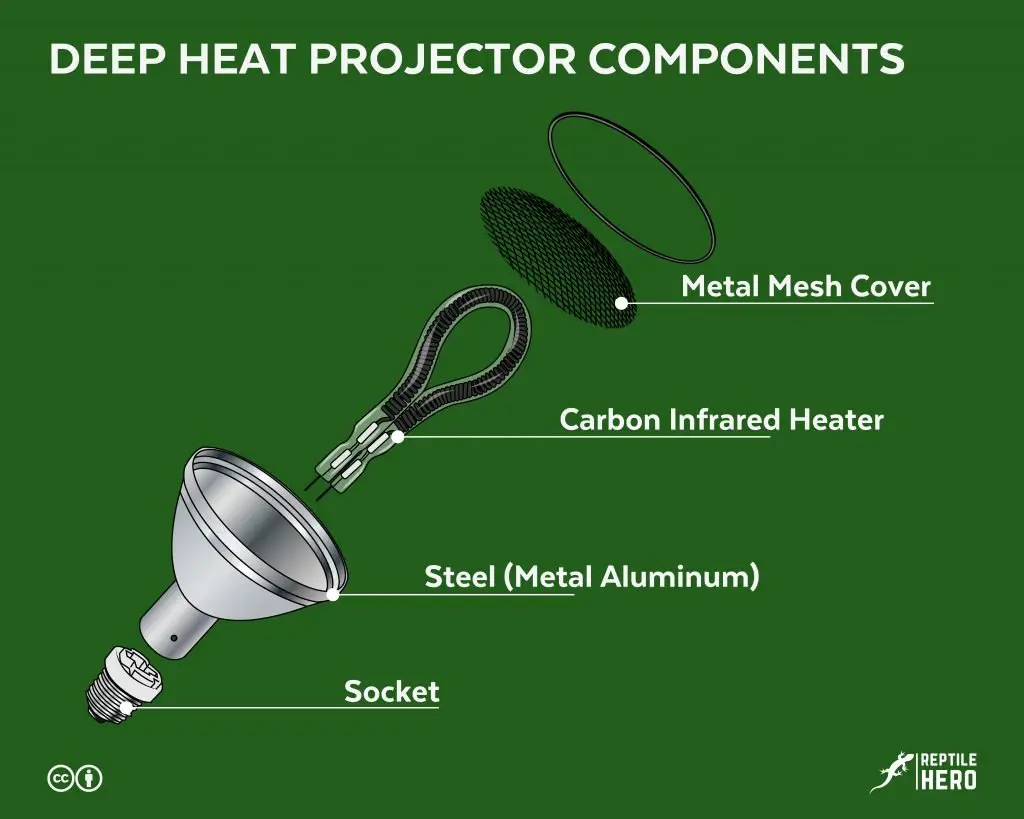
What is in a Deep Heat Projector?
If a halogen heat lamp and a deep heat projector were placed side by side with their lenses faced down in front of you, you will probably have a tough time trying to differentiate between the two. That is unless you look more closely inside the metal shell.
The average deep heat projector is comprised of 3 main parts:
- Bulb: looped bulb with carbon fiber filament coil encased in glass and/or quartz
- Base: standard Edison screw base (E26 in North America and E27 in Europe)
- Housing: parabolic aluminized reflector (PAR) housing with a protective metal mesh cover
How Does a Deep Heat Projector Work?
Similar to ceramic heat emitters and heat mats, a deep heat projector is equipped with a carbon filament. Once it gets really hot, it emits infrared waves through a process called black body radiation and heat through the Joule effect [1].
Once a deep heat projector is properly installed and turned on, an electric current will flow through the coiled carbon fiber heating element that opposes the flowing current. In effect, this is very similar to friction (at electrical level) producing heat and infrared radiation.
A carbon infrared projector doesn’t perfectly replicate the sunlight our leopard geckos can get in nature―8% ultraviolet (UV), 44% full-spectrum visible light, and 48% infrared (IR) [2].
Our sun gives us a lot of near-infrared (IR-A), some mid-infrared (IR-B), and very little far-infrared (IR-C). Near and mid-infrared are considered deep-penetrating heat whereas far-infrared only gives leopard geckos superficial, skin-deep warmth as ambient heat.
Interestingly, IR-A and IR-B can be stored in an object exposed to the sun (e.g., rocks, plants) and subsequently reradiated into its surroundings as IR-C.
The deep heat projector only produces 8% IR-A, 48% infrared B (IR-B or mid-infrared), and 44% is infrared C (IR-C or far-infrared). So make sure that you also have provisions for UV and light in your gecko’s tank for 12 to 14 hours during the day.
Deep Heat Projector for Leopard Geckos: Primary or Supplemental Heater?
Considering the fact that deep heat projectors for reptiles have only recently hit the market, there is still quite a bit of disagreement as to its use for heating. One side says it is sufficient enough for a primary heat source whereas the other side claims that it can only act as a supplemental heater.
A deep heat projector as a primary heat source:
Some keepers use carbon-filament heat projectors as the primary heat source in a leopard gecko tank together with a full-spectrum LED light and a UV-B tube with no problems whatsoever.
In such cases, drops in ambient temperature within the vivarium after sunset aren’t drastic, so nighttime heat is unnecessary. However, if it is needed, the heat projector can also be used from dusk until dawn.
A deep heat projector as a secondary/supplemental heat source:
Most experienced members of the reptile community recommend the use of carbon infrared projectors alongside halogen floodlights for optimal thermal gradient, basking spot, and ambient temperature within the gecko tank.
Typically, this is also done in areas way up in the northern hemisphere (e.g., Canada) to account for overall colder than optimal temperatures (lower than 65°F or 18°C) experienced all year round.
Plus―although leopard geckos don’t normally bask out in the open during daytime―providing a halogen heat lamp that produces a significant amount of IR-A is still advisable for effective cryptic basking. Leopard geckos engage in cryptic basking by only exposing parts of their body to warm themselves up while staying hidden and safe from large predators [3].
The Right Wattage of Deep Heat Projector for Your Gecko Tank (3 Factors)
Selecting the suitable power rating of a carbon-filament deep heat projector for a leopard gecko depends on three main factors.
#1 ‒ Tank Size
Theoretically speaking, the size of a gecko’s tank is directly proportional to the power rating of the heat source needed for its heating. So bigger vivariums need deep heat projectors with a higher wattage.
Unfortunately, since only two wattage options (50W and 80W) were available from the heat projector most available worldwide, it is difficult to determine exact wattage ratings according to tank size―especially because other choices (75W and 100W) have only been introduced in the market only recently. More tests and comparisons across different brands still need to be done for that.
#2 ‒ Overall Tank Material and Design
Glass tanks need higher-powered heat projectors but wood vivariums can make do with low-powered ones, and PVC enclosures need carbon heaters with mid-range power.
In short, the deep projector wattage should be inversely proportional to the heat-insulating capability of the primary material used for a gecko tank. A tank very well insulated will require a lower wattage.
Additionally, since warm air moves up, heat is lost more easily and quickly in a tank with a screen top than in a fully enclosed tank with vent holes. As such screen-topped gecko tanks need higher wattage heat projectors than full-paneled gecko tanks.
#3 ‒ Local Ambient Temperatures
The year-round ambient temperatures experienced in your area should also be taken into consideration.
Leopard gecko keepers living up north (e.g., New York) experience significantly colder weather and therefore need high-powered deep heat projectors than those who live down south (e.g., Arizona).
We all have different circumstances. So instead of trying to use the same deep heat projector one famous leopard gecko owner has, think about what the aforementioned factors are like for you and your gecko to get the right wattage for the tank.
Deep Heat Projector: Is More Power Always Better?
Time and time again, I hear about people advising newbie leopard gecko pet parents to go out and buy the deep heater with the highest power rating they can find.
Because these brand-new heating devices are expensive, they say that going for a 100W or 80W deep heater would be the most practical option since it can be easily dimmed when it produces too much heat for your gecko’s tank.
There are 2 major problems with over dimming oversized deep heat projectors.
#1 – Less deep-penetrating heat, more superficial warmth
If you dim a deep heat projector too much, it will start producing less infrared with shorter wavelengths (IR-A and IR-B) and more infrared with longer wavelengths (IR-C). This isn’t a problem at night.
However, if you do this for daytime heating then it’s not any different from giving your leopard gecko a ceramic heat emitter as the sole heat source.
#2 – Greater risk of burns, dehydration, and fire
In the event that your thermostat fails or malfunctions, an overpowered deep heat projector is likely to cause greater problems once it is set to its rated (too much) wattage due to the broken thermostat.
Think of it this way: if you have to constantly dim the deep heat projector significantly so that it doesn’t feel like an oven inside your leo’s tank, then it’s surely too much for your gecko in the first place.
Should You Use Deep Heat Projectors? 6 Reasons From Leopard Gecko Keepers
Despite being harder to find in the US, the deep heat projector has grown a huge and loyal following among many reptile owners. Below are the most common reasons why leopard gecko owners love using carbon infrared projectors in their pets’ tanks.
#1 ‒ Puts Out Efficient Heat Despite Low Wattage
Deep heat projectors are ordinarily available with a power rating of 50 to 100 Watts (W) but produce heat more efficiently than another non-light-emitting heater with twice the power.
Despite this limited power range, many experienced keepers have successfully used a single 50W heat projector for full-paneled wooden leopard gecko tanks with vents as large as 120 gallons (4x2x2 feet or 120x60x60 centimeters).
A single 50W deep heat projector provides equal―if not better―heating efficiency than any other heating source that has twice the power rating but primarily emits only IR-C (e.g., ceramic heat emitter).
Moreover, unlike other non-light-emitting heating elements, the carbon heat projector can not only boost the air temperature but also provide a good basking spot temperature (95-100°F or 35-38°C) for your leopard gecko tank.
Pro tip: place a dark-colored tile or hide right underneath the deep heat projector so that heat is better absorbed and maintained in your gecko tank’s basking spot. This acts like a natural heat rock that will start gradually letting off the infrared stored in it from daytime sun exposure once night comes so ectothermic animals can still stay warm without sunlight’s infrared radiation.
#2 ‒ Provides Great Thermal Gradients
The average deep heat projector has a parabolic aluminized reflector housing which helps direct the radiation of infrared waves in a more controlled and localized area without adversely intensifying into a tight beam of heat.
If the term parabolic aluminized reflector or PAR rings a bell for you, this is because the design of halogen heat lamps used in reptile husbandry is the same.
You can technically use a deep heat projector without a reflective dome or hood fixture because of its internally reflective aluminum housing.
Instead of having a powerful “spotlight” of heat, your leopard gecko will be given a toasty―not scalding hot― basking surface to lay on when it needs to warm up using a carbon-filament heater.
The heat also spreads out uniformly from the center of the spot the heat projector is directed at to the rest of the area surrounding it. So you will not have trouble getting a comfortable thermal gradient of 70 to 80°F (21-27°C) at the cool side and 85 to 90°F (29-32°C) at the warm side of your leopard gecko’s tank.
#3 ‒ Has a Long Life Span
Currently, the estimated average life span of a deep heat projector is approximately 2-3 years for all-day use and 5-6 years for half-day use.
To be completely clear and honest with you, I don’t think there is any data published out there about the actual average rated life (ARL) or carbon heat projectors since they were only recently produced by other reptile supplies companies.
Deep heat projectors are generally just advertised as “long-lasting” but their manufacturers do not go on to state the exact numbers.
Also, just a few years back, we only really had one option for carbon infrared emitters that were the size of a regular PAR halogen bulb. Space heaters, although similar in technology, are simply too big for the average leopard gecko tank. As such, we don’t have anything else available for proper comparison.
However, my friends and I, along with many other experienced keepers, have gotten years worth of heating with one deep heat projector. Defective and damaged heaters were typically the only ones that lasted less than a year aside from cheap knock-offs and resold used heta projectors.
#4 ‒ Results in More Positive Behavioral Changes
Leopard geckos supplied with deep heat projectors for heating have been observed to display the following positive behaviors:
- Shorter basking periods.
- Reduced hiding.
- Increased activity.
- Better hunting results.
- Improved appetite.
Remember, as cold-blooded or ectothermic animals, leopard geckos rely heavily on their environment to maintain ideal body temperatures and make sure that their body works optimally in terms of locomotion, hunting, feeding, and digestion among many things.
Leopard geckos spend less time basking under deep heat projectors because the presence of IR-A and IR-B allows them to efficiently get warm throughout their body. Hence, they have more time to spare engaging in more enriching activities such as exploring and hunting around the enclosure.

Do bear in mind that different animals will have different initial responses and adjustment periods when their old heat source is replaced with a deep heat projector. Some take only a few days to warm up to having a heat projector.
Other leopard geckos may need months―even a full year―before they react positively to its use in their home. However, I think it’s well worth the wait since their overall well-being seems to improve.
Bonus: many keepers have noted that their leopard geckos experience fewer issues with completely shedding their skin once ceramic heat emitters are replaced with deep heat projectors.
#5 ‒ Does Not Disturb Day-Night Cycles
Although manufacturers claim that deep heat projectors produce no visible light whatsoever, its carbon-fiber filament will still produce a faint red or orange glow at full power due to incandescence―the emission of visible light due to high temperatures.
Most solid objects will give off a yellow, orange, or red glow when it reaches a temperature of 789 Kelvin (equivalent to 977°F or 525 °C) [1]. In comparison, the carbon fiber filament of a deep heat projector can reach an extremely high operating temperature of 1832°F (1000°C).
The light from a fully powered carbon heat projector is estimated to be less than 4 lux. However, this light is not significantly bright enough to disturb your leopard gecko. For context, consider the table below.
| Light Source | Illuminance (lux) |
| Full moon | 0.05‒0.3 |
| Deep heat projector | 4 |
| Hallway lights | 80 |
| Train station lights | 150 |
| Office lights | 320‒500 |
| Sun at dawn or dusk | 400 |
| Direct sunlight | 32000–100000 |
More importantly, the red-orange glow of the carbon filament is eliminated once the heat projector is dimmed for supplemental nighttime heating.
Does 24-Hour Use of Deep Heat Projector Negatively Affect Leopard Geckos?
Many experts in the reptile community say that there is no evidence to suggest that using DHPs as all-day heat sources poses significant harm or risk to leopard geckos. It is much better to provide deep-penetrating heat during considerably cold nights to prevent hypothermia.
Some leopard gecko keepers have shared concerns about using deep heat projectors at night since it produces a considerable amount of IR-B even when dimmed for temperature drops. In their natural habitats, wild leopard geckos only receive IR-B during the day because of sunlight. Thus, they argue that using DHPs at night is unnatural and not advisable.
With that said, using the “best practices” principle in reptile husbandry, small-scale keepers like us as well as large-scale breeders are encouraged to not only provide a naturalistic environment and lifestyle for our beloved leopard geckos.
Instead, experienced keepers and breeders push for improvements in facets of a reptile’s life in captivity even though they can’t naturally get or experience this in the wilderness unless there is human intervention. This is especially true with regards to the optimal day and night heating for leopard geckos.
#6 ‒ Prevents Leopard Geckos From Going Into Brumation
Without the efficient heating of deep heat projectors, especially in places where winter temperatures can drop several degrees below 40°F (4°C), a leopard gecko that has not reached optimal weight is at an increased risk of dying.
Brumation, similar to mammalian hibernation, can be risky for still-developing and underweight leopard geckos who do not have enough fat reserves stored in their tails. In severe cases, it can―and sadly has―lead to death.
You may think I’m exaggerating things, but I am being realistic here. I mean, just think about how wild leopard geckos live out in the wilderness. They have shorter lives compared to geckos kept as pets in captivity.
During winter, brumation can be lethal for leopard geckos even if we put competition for shelter aside. This is especially true for ones that are sick, injured, or still juveniles. Leopard geckos don’t normally care or provide for their young or their colony.
The Best Deep Heat Projector for Your Leopard Geckos
Deep heat projectors have undoubtedly been popularized and normalized by Arcadia, so much so that they are thought to be the only reliable producers of carbon-filament infrared heaters by most keepers I know in the reptile community around the world.
Pros:
- Tried and tested, the heat projector provides IR-A, IR-B, and IR-C. This is useful as you can avoid buying additional secondary heat sources such as ceramic heaters to get the right thermal gradient and a good basking spot.
- At a low power rating of 50W, a medium-sized glass tank and even a large PVC or wooden enclosure can be sufficiently heated without consuming too much electricity. So you can use this with a portable power bank for times of emergency like a blackout.
- Since this heater is completely dimmable, you can hook it up to a dimming thermostat with a day-night temperature setting and use it even at night. Just make sure that your night time temperatures are not higher than 75°F (24°C).
- This carbon infrared projector already has a thick internal reflector, so a dome fixture is not necessary.
- It is available with an E26 base (110/120V) for the US and Canada, and an E27 (220/240V) for the UK. As such, it is compatible with most readily available fixtures and accessories.
- Deep heat projectors from Arcadia have a life span of roughly 2 to 5 years depending on the daily usage time.
Cons
- Although it is said to produce primarily shorter wave infrared, the heat projector emits far more IR-B and IR-C than IR-A. To make up for the lack of sufficient IR-A, you will need to use it with a halogen lamp.
- Contrary to claims, this deep heat projector does produce some faint light during operation but it is not substantially bright or intense enough to disrupt your leopard gecko’s circadian rhythm. Also, dimming will stop the emission of visible light at night.
- Unlike newer released heat projectors by competitors, the Arcadia heat projector does not have a silicone sleeve/cover to prevent damage to the bulb unit itself and avoid burns and fires. So make sure to let the projector cool off before touching it directly.
- Because they are in high demand but there’s very little supply available, a single deep heat projector does come at a steep price of over 20 to 40 bucks―and that’s excluding shipping costs.
Where can you find the Arcadia 50W Deep Heat Projector?
Why Do We Have Only One Deep Heat Projector Recommendation?
About more or less a decade ago, a heat projector similar to the one Arcadia released. However, they never became as popular.
I would even go as far as to say not many people would even be able to correctly name the company that has produced it. Honestly, I don’t even know if it’s already been discontinued or not.
Now, things are a bit different. Ever since carbon-filament heat projectors took the reptile community by storm, many other companies have also introduced their models.
We don’t recommend other heat projectors, at the moment, because the available ones are generally:
- Not widely available
- From a dubious “store/company”
- Only lasted a few days or weeks
- Not efficient with producing heat
- Obvious knockoffs
- Made with bad quality materials
How Do You Install a Deep Heat Projector? (4 Easy Steps)
There are 4 steps to properly installing a deep heat projector in a leopard gecko tank: 1) check, 2) install 3) regulate, and 4) test.
#1 – Check. Thoroughly inspect the deep heat projector for damages and defects before mounting it. Make sure you have the compatible fixture and accessories for it (e.g., ceramic lamp holder, wire guard, lampstand, etc.).
#2 – Install. A deep heat projector can either be installed inside a fully paneled enclosure or outside, above a mesh-top tank.
Either way, it should have a clearance of at least 12 inches (30 centimeters) from the basking spot or topmost layer of the substrate on the tank’s warm side.
This is to prevent your gecko and any other flammable decor or furnishing from coming into direct contact with the element while it’s on.
#3 – Regulate. Similar to most other overhead heat sources, you can regulate the heat output of a carbon infrared heater using a dimming fixture/switch and an on/off thermostat combo as a more affordable alternative (check out the one below, is pretty decent).
A few keepers report experiencing issues when using heat projectors in dimming dome fixtures, however, this is extremely uncommon.
The best way to regulate a deep heat projector is by using it together with a good quality dimming thermostat with a timer function that can be programmed for nighttime temperature drops.
#4 – Test. Ideally, you should test the correct operation of a carbon infrared heater―and any other heat source, for that matter―for at least one full day before introducing an animal into the enclosure for safety purposes.
Don’t expect the heat projector to instantly provide your leopard gecko with a basking spot of 97°F (36°C) within a few minutes of operation. It will take some time for the temperatures within the vivarium to ramp up. But this is not a bad thing since the sun acts similarly in nature.
So keep a close eye on your tank temperatures. Make sure to have at least two digital thermometers. Place one on either side of the tank to get the ambient temperature on both the cool and warm sides.
Have a non-contact thermometer guna like the one above near the tank as well so you can check for the surface temperatures in and around the basking areas.
Takeaways
Heat projectors with carbon fiber filaments emit near, mid, and far-infrared as well as a faint red-orange glow when operated at full power. When dimmed, it no longer gives off any visible light. Furthermore, it produces less short infrared and longer infrared the dimmer it is running.
Even though some keepers have used deep heat projectors as a primary day-and-night heat source for their leopard geckos without any ill effects, it is still recommended to only be used as a supplemental heater for the inadequacy of near-infrared produced.
To select the correct wattage of the carbon heat projector, consider the tank size, overall tank material and design, and the local ambient temperature. It is much better and safer to go for low-wattage heaters than overpowered ones.
Leopard gecko keepers love using deep heat projectors because it puts out substantial heat despite low its limited wattage range, create optimal thermal gradients, last up to about 5 years, encourage positive behaviors, can be used from day to night, and prevents untimely brumation.
Sources
[2] https://www.animalsathomenetwork.com/wp-content/uploads/2020/09/InfraRed-Heating-for-Reptiles.pdf
[3] https://ambassadoranimalsag.files.wordpress.com/2018/09/january-2018-quarterly-newsletter-ahh.pdf

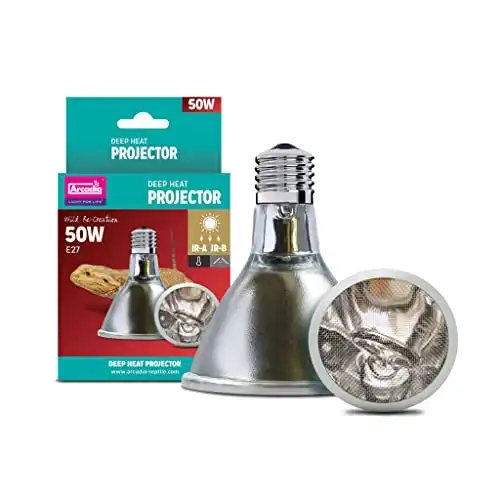

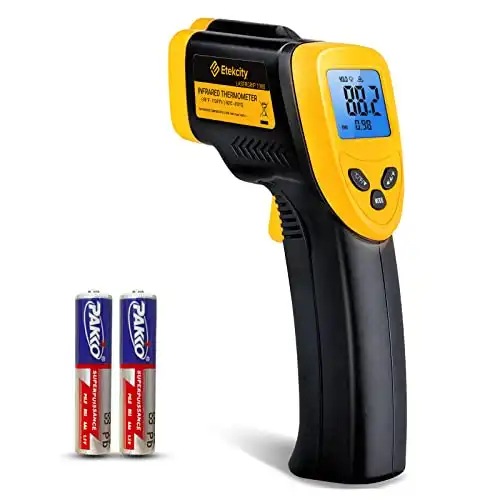
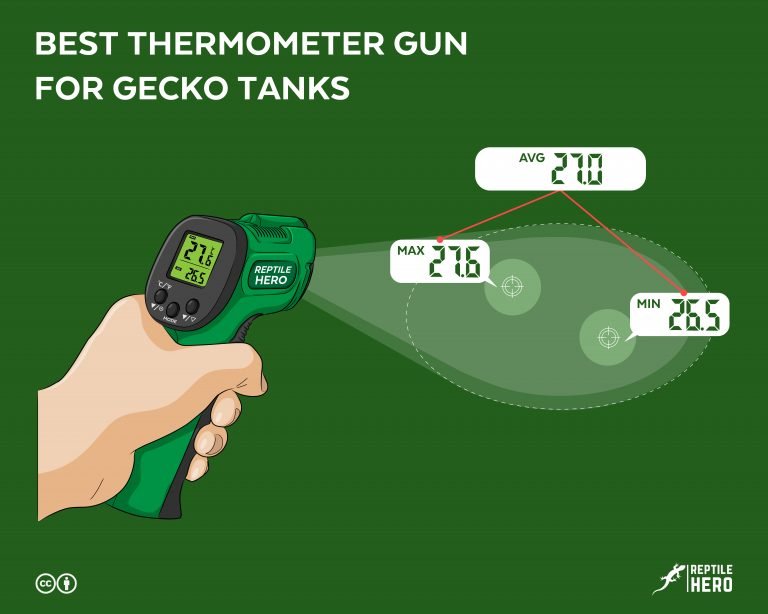
![Human Foods Geckos Can And Can’t Eat [Massive List Ahead]](https://www.reptilehero.com/wp-content/uploads/2022/06/food-geckos-can-and-cant-eat-cc-768x614.jpg)
